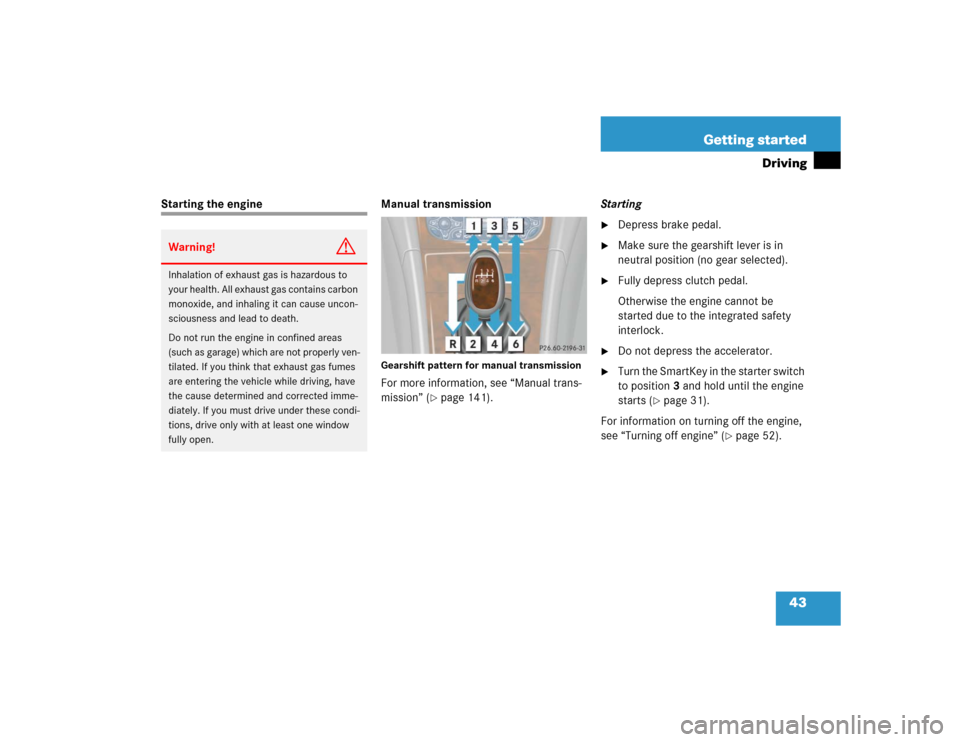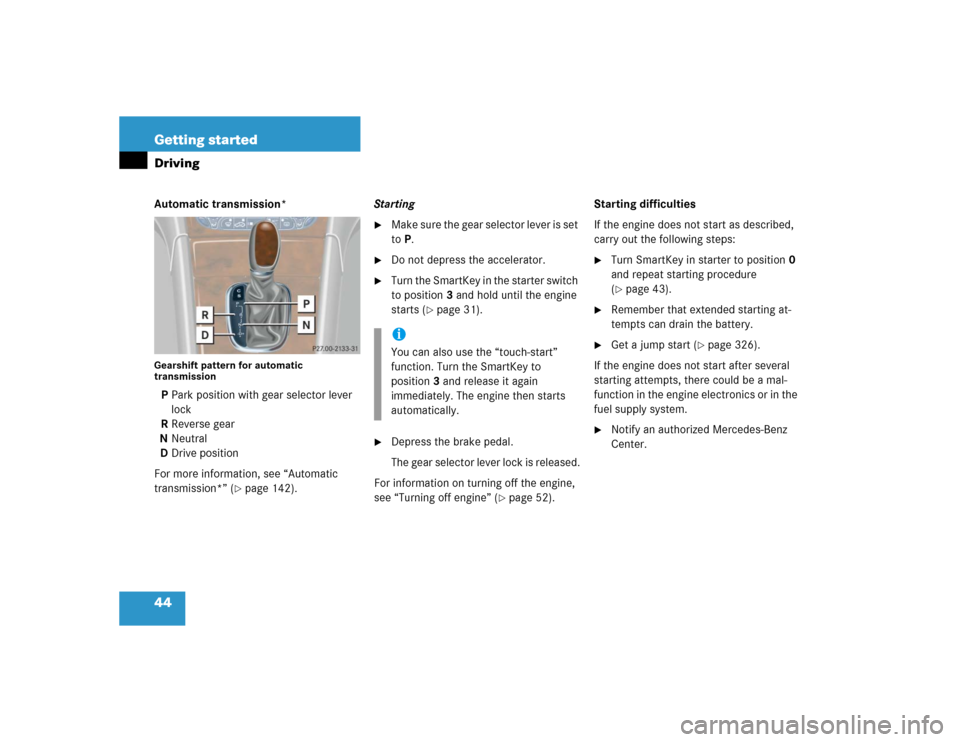Page 30 of 400
30 Getting startedUnlocking
�The “Getting started” section provides an
overview of the vehicle’s most basic func-
tions. First-time Mercedes-Benz owners
should pay special attention to the infor-
mation given here.
If you are already familiar with the basic
functions described here, the “Controls in
detail” section will provide you with further
information. The corresponding page
references are located at the end of each
segment.
Unlocking
Unlocking with the SmartKeySmartKey with remote control 1‹Lock button
2ŠOpening button for the trunk lid
3ŒUnlock button
4ÂPanic button* (
�page 71)
�
Press unlock buttonΠon the
SmartKey.
All turn signal lamps flash once. The
locking knobs in the doors move up.
�
Get in the vehicle and insert the
SmartKey in the starter switch.
For more information, see “Locking and
unlocking” (
�page 82).
iCanada only:
Only vehicles equipped with an
anti-theft alarm system* have
SmartKeys with integrated panic
button*4.
Page 31 of 400

31 Getting started
Unlocking
Starter switch positionsStarter switch0For removing SmartKey
The steering is locked when the
SmartKey is removed from the starter
switch. If necessary, move steering
wheel slightly to allow the locking
mechanism to engage.
1Power supply to some electrical
consumers, such as seat adjustment
2Ignition (power supply for all electrical
consumers) and driving position
3Starting position
Warning!
G
When leaving the vehicle, always remove the
SmartKey from the starter switch and lock
the vehicle. Do not leave children unattend-
ed in the vehicle, or with access to an un-
locked vehicle. Unsupervised use of vehicle
equipment may cause an accident and/or
serious personal injury.iVehicles with automatic transmission:
The SmartKey can only be removed
from the starter switch with the gear
selector lever in positionP.
!If the SmartKey cannot be turned in the
starter switch, the battery may not be
sufficiently charged.�
Check the battery and charge it if
necessary (
�page 323).
�
Get a jump start (
�page 326).
To prevent accelerated battery
discharge and a possible dead battery,
always remove the SmartKey from the
starter switch when the engine is not in
operation.
Page 32 of 400

32 Getting startedAdjusting
�AdjustingSeats
The seats can be adjusted either manually
or electrically, depending on the vehicle’s
equipment.Warning!
G
All seat, head restraint, steering wheel, and
rear view mirror adjustments, as well as fas-
tening of seat belts, must be done before
the vehicle is put into motion.Warning!
G
Do not adjust the driver’s seat while driving.
Adjusting the seat while driving could cause
the driver to lose control of the vehicle.
Never ride in a moving vehicle with the seat
back reclined. Sitting in an excessively re-
clined position can be dangerous. You could
slide under the seat belt in a collision. If you
slide under it, the belt would apply force at
the abdomen or neck.
That could cause serious or fatal injuries.
The seat back and seat belts provide the
best restraint when the wearer is in an up-
right position and belts are properly posi-
tioned on the body. Your seat must be
adjusted so that you can correctly fasten
your seat belt (
�page 40).
Never place hands under the seat or near
any moving parts while a seat is being ad-
justed.
Warning!
G
When leaving the vehicle, always remove the
SmartKey from the starter switch, and lock
your vehicle.
The power seats* can also be operated with
the driver’s or front passenger door open.
Do not leave children unattended in the ve-
hicle, or with access to an unlocked vehicle.
Unsupervised use of vehicle equipment may
cause an accident and/or serious personal
injury.
Warning!
G
Children 12 years old and under must never
ride in the front seat, except in a
Mercedes-Benz authorized BabySmart
TM1
compatible child seat, which operates with
the BabySmart
TM system installed in the ve-
hicle to deactivate the passenger front air-
bag when it is properly installed. Otherwise
they will be struck by the airbag when it in-
flates in a crash. If this happens, serious or
fatal injury will result.
According to accident statistics, children
are safer when properly restrained in the
rear seating positions than in the front seat-
ing positions. Infants and small children
must ride in back seats and be seated in an
appropriate infant or child restraint system,
which is properly secured with the vehicle’s
seat belt and top tether strap, or secured via
lower anchors and top tether strap, fully in
accordance with the child seat manufactur-
er’s instructions.
1BabySmart
TM is a trademark of Siemens
Automotive Corp.
Page 36 of 400

36 Getting startedAdjusting
Head restraint tilt
Manually adjust the angle of the head
restraint.�
Push or pull on the lower edge of the
head restraint cushion.
For more information, see “Seats”
(
�page 92).
Steering wheel
Warning!
G
For your protection, drive only with properly
positioned head restraints.
Adjust head restraint so that the head
restraint supports the back of the head at
eye level. This will reduce the potential for
injury to the head and neck in the event of
an accident or similar situation.
Do not drive the vehicle without the seat
head restraints. Head restraints are
intended to help reduce injuries during an
accident.
Warning!
G
Do not adjust the steering wheel while
driving. Adjusting the steering wheel while
driving, or driving without the adjustment
locked could cause the driver to lose control
of the vehicle.
When leaving the vehicle, always remove the
SmartKey from the starter switch and lock
your vehicle.
The electrical steering wheel adjustment
feature* can also be operated with the
driver’s door open. Do not leave children
unattended in the vehicle, or with access to
an unlocked vehicle. Unsupervised use of
vehicle equipment may cause an accident
and/or serious personal injury.
Page 37 of 400
37 Getting started
Adjusting
Steering wheel adjustment, manual
1Handle�
To unlock the steering column, pull
handle1 out to its stop limit.
�
Move steering wheel to the desired
position.
�
To lock the steering column, push
handle1 all the way in until it
engages.
The steering wheel is once again
locked into position.Steering wheel adjustment, electrical*
The stalk for steering wheel adjustment is
located on the steering column (lower left).
1Adjusting steering column, in or out
2Adjusting steering column, up or down
�
Turn the SmartKey in the starter switch
to position1 or2 (
�page 31).
or
�
Open the driver’s door.
!Do not drive the vehicle until you have
properly locked the steering column.
If the warning message
STEERING
WHEEL ADJ. - LOCK!
(�page 298) is
displayed while the engine is running,
the steering column is not locked.
Page 43 of 400

43 Getting started
Driving
Starting the engine Manual transmission
Gearshift pattern for manual transmissionFor more information, see “Manual trans-
mission” (
�page 141).Starting
�
Depress brake pedal.
�
Make sure the gearshift lever is in
neutral position (no gear selected).
�
Fully depress clutch pedal.
Otherwise the engine cannot be
started due to the integrated safety
interlock.
�
Do not depress the accelerator.
�
Turn the SmartKey in the starter switch
to position3 and hold until the engine
starts (
�page 31).
For information on turning off the engine,
see “Turning off engine” (
�page 52).
Warning!
G
Inhalation of exhaust gas is hazardous to
your health. All exhaust gas contains carbon
monoxide, and inhaling it can cause uncon-
sciousness and lead to death.
Do not run the engine in confined areas
(such as garage) which are not properly ven-
tilated. If you think that exhaust gas fumes
are entering the vehicle while driving, have
the cause determined and corrected imme-
diately. If you must drive under these condi-
tions, drive only with at least one window
fully open.
Page 44 of 400

44 Getting startedDrivingAutomatic transmission*Gearshift pattern for automatic
transmissionPPark position with gear selector lever
lock
RReverse gear
NNeutral
DDrive position
For more information, see “Automatic
transmission*” (
�page 142).Starting
�
Make sure the gear selector lever is set
toP.
�
Do not depress the accelerator.
�
Turn the SmartKey in the starter switch
to position3 and hold until the engine
starts (
�page 31).
�
Depress the brake pedal.
The gear selector lever lock is released.
For information on turning off the engine,
see “Turning off engine” (
�page 52).Starting difficulties
If the engine does not start as described,
carry out the following steps:
�
Turn SmartKey in starter to position0
and repeat starting procedure
(�page 43).
�
Remember that extended starting at-
tempts can drain the battery.
�
Get a jump start (
�page 326).
If the engine does not start after several
starting attempts, there could be a mal-
function in the engine electronics or in the
fuel supply system.
�
Notify an authorized Mercedes-Benz
Center.
iYou can also use the “touch-start”
function. Turn the SmartKey to
position3 and release it again
immediately. The engine then starts
automatically.
Page 45 of 400

45 Getting started
Driving
Parking brake
1Release handle
2Parking brake
�
Release parking brake by pulling on
handle1.
The warning lamp; (USA only)
or3 (Canada only) in the
instrument cluster goes out.
Driving
�
Depress the brake pedal.
�
Move gear selector lever to positionD
orR (manual transmission: first or
reverse gear).
�
Release the brake pedal.
�
Carefully depress the accelerator.
Once the vehicle is in motion, the auto-
matic central locking system engages
and the locking knobs drop down.
Warning!
G
When leaving the vehicle, always remove the
SmartKey from the starter switch and lock
the vehicle. Do not leave children unattend-
ed in the vehicle, or with access to an un-
locked vehicle. Children could release the
parking brake, which could result in an acci-
dent and/or serious injury.
iVehicles with automatic transmission:
Wait for the gear selection process to
complete before setting the vehicle in
motion.
iYou can open a locked door from the
inside. Open door only when conditions
are safe to do so.
You can deactivate the automatic
locking using the control system
(�page 133).
!Simultaneously depressing the
accelerator pedal and applying the
brake reduces engine performance and
causes premature brake and drivetrain
wear.!If you hear a warning signal when driv-
ing off, you have forgotten to release
the parking brake.
Release the parking brake.